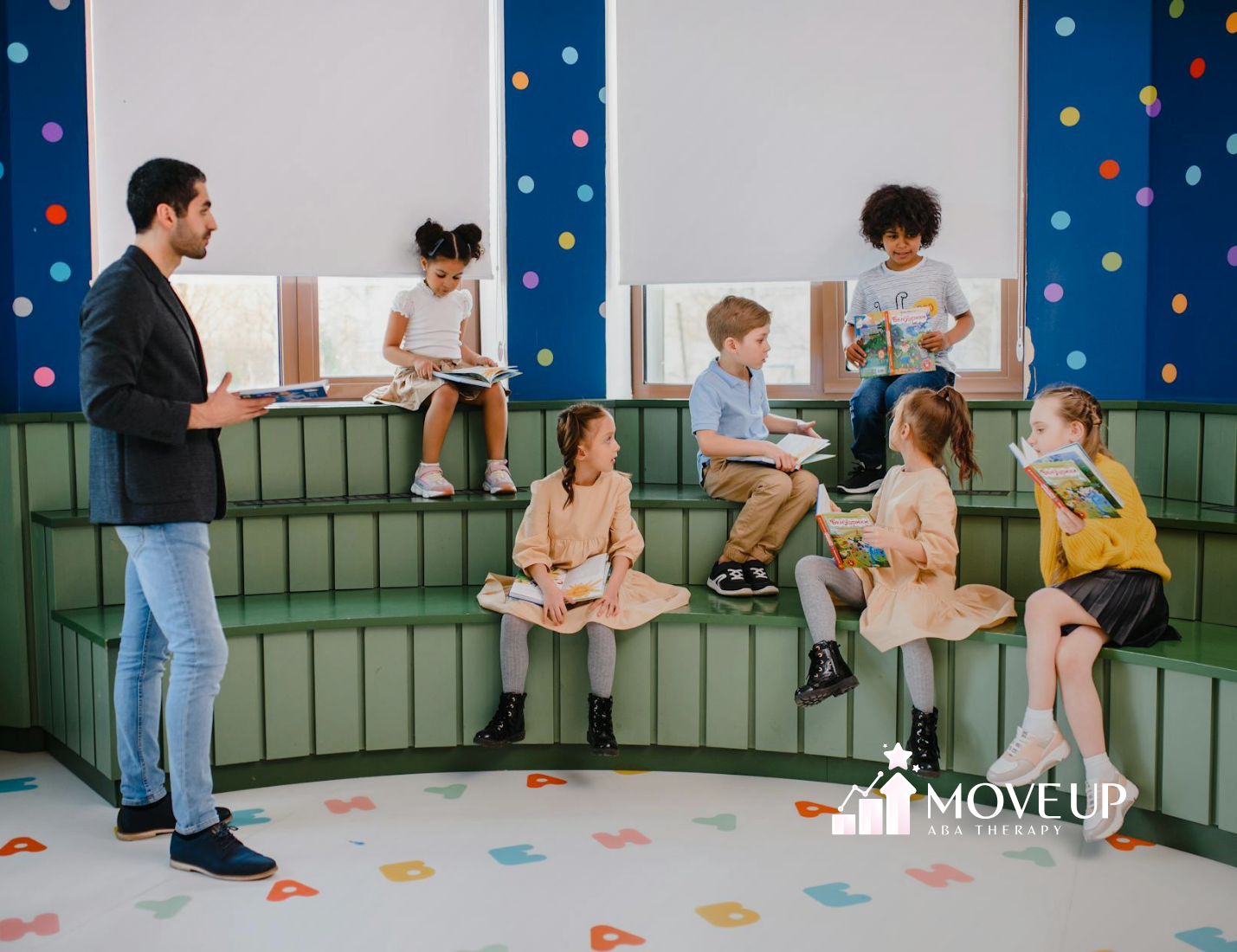Child-led ABA therapy is an innovative approach that is transforming how we view and implement applied behavior analysis (ABA) therapy, especially during early intervention. Unlike traditional models, this method shifts the focus from a therapist-directed approach to one where a child’s interests are front and center. This method aims to create a more engaging, motivating, and effective learning experience for children.
Understanding Child-Led ABA Therapy
Applied Behavior Analysis (ABA) therapy has been recognized as an effective intervention for children with autism spectrum disorder (ASD). While traditional ABA therapy often uses structured teaching methods, child-led ABA therapy stands out.
This approach emphasizes the importance of incorporating a child’s interests and motivations into every aspect of their treatment. By allowing children to guide the activities, therapists can unlock a world of learning opportunities and promote genuine engagement.
Defining Child-Led ABA Therapy
Child-led ABA therapy is a type of ABA therapy that uses the principles of behavior analysis to teach new skills in a natural environment, primarily through play. Unlike traditional ABA, which often uses a structured, therapist-directed approach, child-led ABA follows the child’s lead and uses their interests to motivate learning.
For instance, if a child is deeply interested in dinosaurs, a therapist employing child-led ABA might use dinosaur toys to teach social skills, language skills, or other targeted behaviors. This approach not only makes learning more enjoyable for the child, but also helps to generalize skills to more natural settings.
This strategy is based on the idea that learning is most effective when children are engaged and motivated. By allowing children to choose their activities, therapists can create a more natural and enjoyable learning experience.
The Core Principles of Child-Led ABA
One of the core principles of child-led ABA is the emphasis on positive reinforcement. Therapists and parents use praise, rewards, and other forms of positive reinforcement to motivate children and encourage desired behaviors.
By focusing on a child’s interests, sessions become inherently rewarding, reducing the need for external motivators, and promoting genuine enjoyment in learning. This positive learning experience sets the stage for the child to associate learning with positive emotions, fostering a love for exploration and a desire to discover.
Furthermore, this approach encourages therapists to become keen observers, paying close attention to what motivates children and tailoring their ABA treatment accordingly. Rather than rigidly adhering to a preset plan, therapists adapt their strategies based on the child’s cues and responses, making each session a truly individualized experience.
The Importance of Child-Led Techniques in ABA
Child-led techniques are not merely a shift in methodology, but a fundamental philosophy that recognizes the child’s intrinsic motivation as a driving force in the therapeutic process. This approach acknowledges that children aren’t passive recipients of information; they are active learners, eager to explore, discover, and engage with the world around them.
By tapping into this natural curiosity, therapists can unlock a child’s potential, making therapy a truly collaborative journey toward growth and development.
Recognizing the Child’s Role in Their Learning Process
Incorporating child-led techniques in ABA is not about relinquishing structure; it’s about shifting the focus to the child as an active participant. It emphasizes learner engagement as the cornerstone of effective teaching. By providing children with choices and opportunities to pursue their interests, therapists can cultivate an environment where learning becomes an enjoyable adventure, rather than a chore.
When children feel heard and respected, their engagement soars. Through play-based activities and carefully crafted scenarios, children organically develop essential social skills, communication skills, and other abilities critical for their overall development. By observing their interactions, therapists gain valuable insights into their strengths, challenges, and unique learning styles.
This deeper understanding allows therapists to tailor their ABA therapy to address specific needs, ensuring that each child progresses at their own pace and reaches their full potential.
How Child-Led ABA Therapy Empowers Children
Child-led ABA therapy extends beyond skill acquisition; it empowers children to become active agents in their learning process. This approach fosters self-initiated learning by allowing children to communicate their preferences and make choices.
As children see their ideas valued and their decisions respected, they develop a sense of ownership over their learning. This ownership translates to increased confidence, as children begin to view themselves as capable learners, eager to take on new challenges.
Furthermore, child-led ABA promotes autonomy by providing opportunities for children to initiate activities, advocate for their needs, and express themselves freely. This newfound independence extends beyond the therapy room, equipping children with the skills and confidence to navigate various social situations and advocate for themselves effectively.
Child-led ABA therapy offers a personalized approach that focuses on your child’s interests and unique pace of learning. For families searching for in-home ABA therapy near me, this approach ensures therapy sessions are engaging, effective, and tailored to your child’s environment. Take the first step toward meaningful progress—connect with a trusted ABA provider today!
Practical Strategies for Implementing Child-Led ABA
Transitioning to a child-led approach requires careful planning, observation, and a genuine desire to connect with the child on their level. The first step is to fully embrace the child’s interests. What are they naturally drawn to? What excites them and captures their attention?
Understanding a child’s passions provides the building blocks for creating meaningful learning opportunities. By weaving their interests into therapeutic activities, therapists can tap into their intrinsic motivation, making learning a joyful and engaging experience.
Identifying Child Interests and Preferences
Taking the time to truly understand a child’s needs and preferences is essential. Spend time observing what captures their attention. Speak to parents and caregivers to learn about the child’s favorite toys, activities, and routines.
Here are some key areas to focus on when identifying a child’s interests:
- Observe their Play: What activities do they naturally gravitate towards?
- Listen Attentively: Pay close attention to their verbal and nonverbal communication.
- Consider Sensory Preferences: What types of sensory input do they seem to enjoy or avoid?
By using this information, you can start to incorporate a child’s interests into their ABA therapy sessions, making learning more engaging and effective.
Adapting Environments for Effective Child-Led Learning
The learning environment plays a crucial role in successfully implementing a child-led approach in ABA. Create a designated play area that sparks joy and invites exploration. Fill it with a variety of toys and materials that align with the child’s interests, offering ample opportunities for them to initiate play and demonstrate their creativity.
Maintain a predictable schedule and routine, as this provides a sense of security and helps children anticipate transitions more readily. Flexibility is key in a child-led approach. Remain open to adjusting plans based on the child’s interests and engagement level.
If a child seems disinterested in a planned activity, skillfully redirect their attention by introducing a preferred toy or activity that incorporates the same skill or concept. By adapting to their needs and interests, you create a dynamic learning environment that fosters collaboration and empowers children to take ownership of their learning journey.
Conclusion
Child-Led ABA Therapy places children at the forefront of their learning journey, empowering them to thrive through personalized strategies and environments. By recognizing and adapting to their interests and preferences, this approach fosters a sense of autonomy crucial for development. Parents play a vital role in supporting Child-Led ABA at home, creating a harmonious blend of structured therapy and everyday interactions. This methodology stands out from traditional ABA by emphasizing individualized engagement, ultimately enhancing children’s learning experience and outcomes. Embrace the power of Child-Led ABA to unleash your child’s potential and promote holistic growth.
Move Up ABA is revolutionizing the way autism therapy is delivered, placing your child’s unique needs and preferences at the heart of their approach. By embracing child-led ABA therapy, Move Up ABA empowers children to take an active role in their growth, fostering confidence, skill development, and genuine progress. Experience personalized care that truly makes a difference—reach out to Move Up ABA today and watch your child thrive!
Frequently Asked Questions
What Makes Child-Led ABA Different from Traditional ABA?
While both types of ABA therapy aim to teach new skills, child-led ABA differs from traditional ABA by placing a greater emphasis on the child’s role in directing the learning process. This approach prioritizes flexibility, creativity, and tailoring sessions around the child’s interests to maximize engagement and motivation.
How Can Parents Support Child-Led ABA at Home?
Parental involvement is vital in supporting child-led ABA at home. It is essential to create a supportive home environment that reinforces the strategies and skills learned during therapy sessions. Consistency with reinforcement strategies, open communication with the therapist, and active participation in the child’s progress are crucial for successful implementation.
How can ABA therapy help my child?
ABA therapy can benefit children by improving their communication skills, social development, and reducing challenging behaviors. Working with a certified behavior analyst (BCBA) to create a tailored treatment plan can help your child thrive in various aspects of life.
Sources:
- https://www.nimh.nih.gov/health/topics/autism-spectrum-disorders-asd
- https://mindfulbehaviorllc.org/wp-content/uploads/2023/07/Child-Led-ABA.pdf
- https://www.verywellmind.com/what-is-positive-reinforcement-2795412
- http://relational-integrative-psychotherapy.uk/chapters/engaging-the-therapeutic-process/






